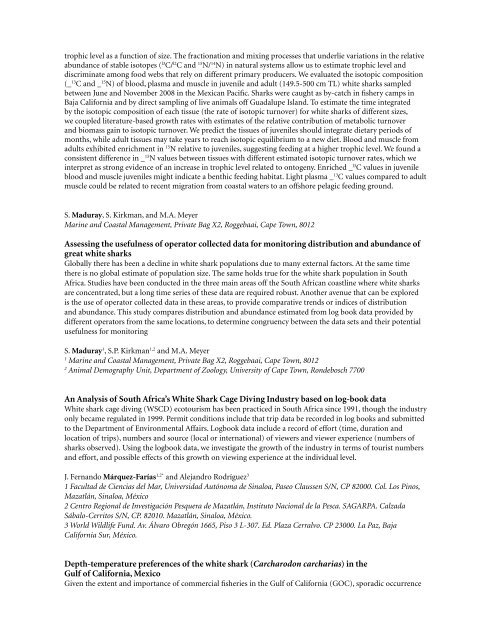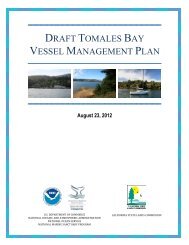Symposium program - Gulf of the Farallones National Marine ...
Symposium program - Gulf of the Farallones National Marine ...
Symposium program - Gulf of the Farallones National Marine ...
Create successful ePaper yourself
Turn your PDF publications into a flip-book with our unique Google optimized e-Paper software.
trophic level as a function <strong>of</strong> size. The fractionation and mixing processes that underlie variations in <strong>the</strong> relative<br />
abundance <strong>of</strong> stable isotopes ( l3 C/ l2 C and 15 N/ 14 N) in natural systems allow us to estimate trophic level and<br />
discriminate among food webs that rely on different primary producers. We evaluated <strong>the</strong> isotopic composition<br />
(_ 13 C and _ 15 N) <strong>of</strong> blood, plasma and muscle in juvenile and adult (149.5-500 cm TL) white sharks sampled<br />
between June and November 2008 in <strong>the</strong> Mexican Pacific. Sharks were caught as by-catch in fishery camps in<br />
Baja California and by direct sampling <strong>of</strong> live animals <strong>of</strong>f Guadalupe Island. To estimate <strong>the</strong> time integrated<br />
by <strong>the</strong> isotopic composition <strong>of</strong> each tissue (<strong>the</strong> rate <strong>of</strong> isotopic turnover) for white sharks <strong>of</strong> different sizes,<br />
we coupled literature-based growth rates with estimates <strong>of</strong> <strong>the</strong> relative contribution <strong>of</strong> metabolic turnover<br />
and biomass gain to isotopic turnover. We predict <strong>the</strong> tissues <strong>of</strong> juveniles should integrate dietary periods <strong>of</strong><br />
months, while adult tissues may take years to reach isotopic equilibrium to a new diet. Blood and muscle from<br />
adults exhibited enrichment in 15 N relative to juveniles, suggesting feeding at a higher trophic level. We found a<br />
consistent difference in _ 15 N values between tissues with different estimated isotopic turnover rates, which we<br />
interpret as strong evidence <strong>of</strong> an increase in trophic level related to ontogeny. Enriched _ l3 C values in juvenile<br />
blood and muscle juveniles might indicate a benthic feeding habitat. Light plasma _ 13 C values compared to adult<br />
muscle could be related to recent migration from coastal waters to an <strong>of</strong>fshore pelagic feeding ground.<br />
S. Maduray, S. Kirkman, and M.A. Meyer<br />
<strong>Marine</strong> and Coastal Management, Private Bag X2, Roggebaai, Cape Town, 8012<br />
Assessing <strong>the</strong> usefulness <strong>of</strong> operator collected data for monitoring distribution and abundance <strong>of</strong><br />
great white sharks<br />
Globally <strong>the</strong>re has been a decline in white shark populations due to many external factors. At <strong>the</strong> same time<br />
<strong>the</strong>re is no global estimate <strong>of</strong> population size. The same holds true for <strong>the</strong> white shark population in South<br />
Africa. Studies have been conducted in <strong>the</strong> three main areas <strong>of</strong>f <strong>the</strong> South African coastline where white sharks<br />
are concentrated, but a long time series <strong>of</strong> <strong>the</strong>se data are required robust. Ano<strong>the</strong>r avenue that can be explored<br />
is <strong>the</strong> use <strong>of</strong> operator collected data in <strong>the</strong>se areas, to provide comparative trends or indices <strong>of</strong> distribution<br />
and abundance. This study compares distribution and abundance estimated from log book data provided by<br />
different operators from <strong>the</strong> same locations, to determine congruency between <strong>the</strong> data sets and <strong>the</strong>ir potential<br />
usefulness for monitoring<br />
S. Maduray 1 , S.P. Kirkman 1,2 and M.A. Meyer<br />
1<br />
<strong>Marine</strong> and Coastal Management, Private Bag X2, Roggebaai, Cape Town, 8012<br />
2<br />
Animal Demography Unit, Department <strong>of</strong> Zoology, University <strong>of</strong> Cape Town, Rondebosch 7700<br />
An Analysis <strong>of</strong> South Africa’s White Shark Cage Diving Industry based on log-book data<br />
White shark cage diving (WSCD) ecotourism has been practiced in South Africa since 1991, though <strong>the</strong> industry<br />
only became regulated in 1999. Permit conditions include that trip data be recorded in log books and submitted<br />
to <strong>the</strong> Department <strong>of</strong> Environmental Affairs. Logbook data include a record <strong>of</strong> effort (time, duration and<br />
location <strong>of</strong> trips), numbers and source (local or international) <strong>of</strong> viewers and viewer experience (numbers <strong>of</strong><br />
sharks observed). Using <strong>the</strong> logbook data, we investigate <strong>the</strong> growth <strong>of</strong> <strong>the</strong> industry in terms <strong>of</strong> tourist numbers<br />
and effort, and possible effects <strong>of</strong> this growth on viewing experience at <strong>the</strong> individual level.<br />
J. Fernando Márquez-Farías 1,2* and Alejandro Rodríguez 3<br />
1 Facultad de Ciencias del Mar, Universidad Autónoma de Sinaloa, Paseo Claussen S/N, CP 82000. Col. Los Pinos,<br />
Mazatlán, Sinaloa, México<br />
2 Centro Regional de Investigación Pesquera de Mazatlán, Instituto Nacional de la Pesca. SAGARPA. Calzada<br />
Sábalo-Cerritos S/N, CP. 82010. Mazatlán, Sinaloa, México.<br />
3 World Wildlife Fund. Av. Álvaro Obregón 1665, Piso 3 L-307. Ed. Plaza Cerralvo. CP 23000. La Paz, Baja<br />
California Sur, México.<br />
Depth-temperature preferences <strong>of</strong> <strong>the</strong> white shark (Carcharodon carcharias) in <strong>the</strong><br />
<strong>Gulf</strong> <strong>of</strong> California, Mexico<br />
Given <strong>the</strong> extent and importance <strong>of</strong> commercial fisheries in <strong>the</strong> <strong>Gulf</strong> <strong>of</strong> California (GOC), sporadic occurrence







